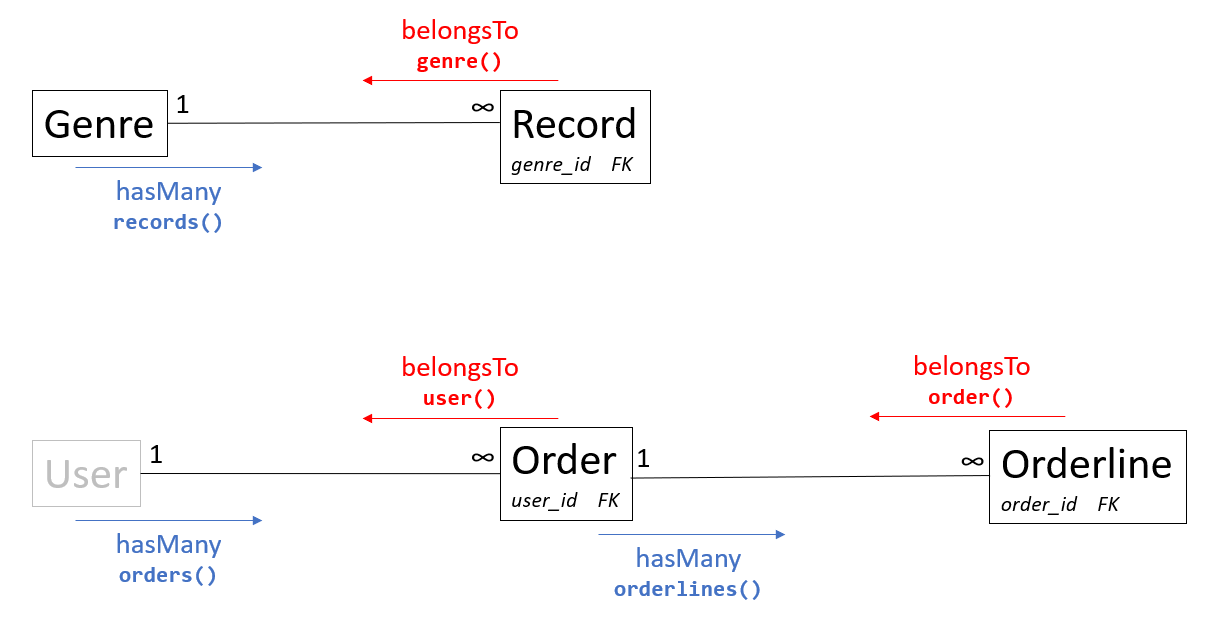Eloquent models
- In the previous section, we created model classes for all the database tables
- All models can be found in the root of the app folder
- The Eloquent ORM (Object-Relational Mapping) included with Laravel provides a beautiful, simple ActiveRecord implementation for working with your database
- Each database table has a corresponding model which is used to interact with that table
- In fact, the model represents a single row in the table
- Models allow you to query for data in your tables, as well as insert, update or delete a specific table row
Add relationships
- The relations between the primary keys and foreign keys are already defined in MySql (through the code in the corresponding migrations)
- It's also necessary to define those relations in the Eloquent models
- The database of our application only contains one-to-many and many-to-one relations
Genre 1 <-> ∞ Record
- If we consider this relation as a one-to-many (1 -> ∞) relationship, we can say that "a genre has many records"
- In Eloquent, we define this relationship by applying the
hasMany()method on our Genre model, with the Record model ('App\Record') as parameter - Eloquent will automatically determine the proper foreign key column in the Record model, i.e.
genre_id(the name of the owning model, suffixed with_id) - The former code should be wrapped in a method
records(), which shall be used later on to query all the records of a specific genre
- In Eloquent, we define this relationship by applying the
class Genre extends Model
{
public function records()
{
return $this->hasMany('App\Record'); // a genre has many records
}
}
1
2
3
4
5
6
7
2
3
4
5
6
7
NAMING CONVENTIONS hasMany()
The relationship method should be named according to the used model (with lower case), and plural case
Full method: hasMany('model', 'foreign_key', 'primary_key')
- The first parameter is the model to refer to (
Record) - You may omit the third parameter if the primary key of the referred model (
Record) is namedid - You may omit the second parameter if the foreign key of the owning model (
Genre) is the the "snake_case" name of the owning model, suffixed with_id
class Genre extends Model
{
public function records()
{
// long version
return $this->hasMany('App\Record', 'genre_id', 'id');
// short version
return $this->hasMany('App\Record');
}
}
1
2
3
4
5
6
7
8
9
10
2
3
4
5
6
7
8
9
10
More info: One To Many
- Inversely, we can look at the same relation as a many-to-one (∞ -> 1) relationship: "a record belongs to a genre"
- In Eloquent, we define this relationship by applying the
belongsTo()method on our Record model, with the Genre model ('App\Genre') as parameter - Eloquent will try to match the
genre_idfrom the Record model to anidin the Genre model- The
withDefault()method returns an empty Genre model (instead ofnull) if thegenre_iddoes not match anidin the Genre model, which results in less conditional checks (and is often referred to as the Null object pattern)
- The
- The former code should be wrapped in a method
genre(), which shall be used later on to query the genre of a specific record
- In Eloquent, we define this relationship by applying the
class Record extends Model
{
public function genre()
{
return $this->belongsTo('App\Genre')->withDefault(); // a record belongs to a genre
}
}
1
2
3
4
5
6
7
2
3
4
5
6
7
NAMING CONVENTIONS belongsTo()
The relationship method should be named according to the used model (with lower case), and singular case
Full method: belongsTo('model', 'foreign_key', 'primary_key')
- The first parameter is the model to refer to (
Genre) - You may omit the third parameter if the primary key of the referred model (
Genre) is namedid - You may omit the second parameter if the foreign key of the owning model (
Record) is named the name of the relationship method, suffixed with_id
class Record extends Model
{
public function genre()
{
// long version
return $this->belongsTo('App\Genre', 'genre_id', 'id')->withDefault();
// short version
return $this->belongsTo('App\Genre')->withDefault();
}
}
1
2
3
4
5
6
7
8
9
10
2
3
4
5
6
7
8
9
10
More info: One To Many (Inverse)
EXERCISE: Define the other relations in the Eloquent models
User 1 <-> ∞ Order
// App/User.php
public function orders()
{
return $this->hasMany('App\Order'); // a user has many orders
}
1
2
3
4
5
2
3
4
5
// App/Order.php
public function user()
{
return $this->belongsTo('App\User')->withDefault(); // an order belongs to a user
}
1
2
3
4
5
2
3
4
5
Order 1 <-> ∞ Orderline
// App/Order.php
public function orderlines()
{
return $this->hasMany('App\Orderline'); // an order has many orderlines
}
1
2
3
4
5
2
3
4
5
// App/Orderline.php
public function order()
{
return $this->belongsTo('App\Order')->withDefault(); // an orderline belongs to an order
}
1
2
3
4
5
2
3
4
5
SUMMARY
